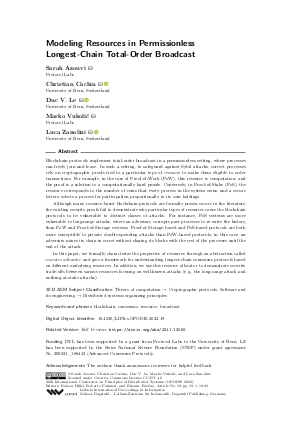@InProceedings{azouvi_et_al:LIPIcs.OPODIS.2022.19,
author = {Azouvi, Sarah and Cachin, Christian and Le, Duc V. and Vukoli\'{c}, Marko and Zanolini, Luca},
title = {{Modeling Resources in Permissionless Longest-Chain Total-Order Broadcast}},
booktitle = {26th International Conference on Principles of Distributed Systems (OPODIS 2022)},
pages = {19:1--19:23},
series = {Leibniz International Proceedings in Informatics (LIPIcs)},
ISBN = {978-3-95977-265-5},
ISSN = {1868-8969},
year = {2023},
volume = {253},
editor = {Hillel, Eshcar and Palmieri, Roberto and Rivi\`{e}re, Etienne},
publisher = {Schloss Dagstuhl -- Leibniz-Zentrum f{\"u}r Informatik},
address = {Dagstuhl, Germany},
URL = {https://drops.dagstuhl.de/entities/document/10.4230/LIPIcs.OPODIS.2022.19},
URN = {urn:nbn:de:0030-drops-176398},
doi = {10.4230/LIPIcs.OPODIS.2022.19},
annote = {Keywords: blockchain, consensus, resource, broadcast}
}

 Creative Commons Attribution 4.0 International license
Creative Commons Attribution 4.0 International license






















